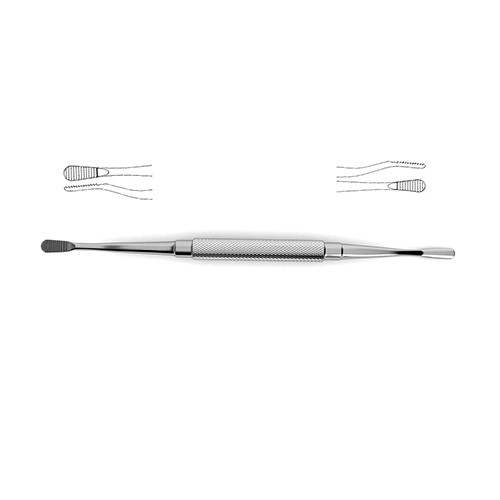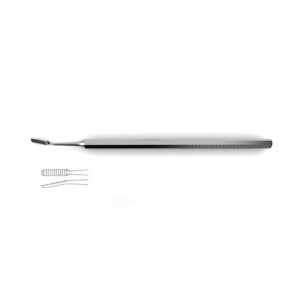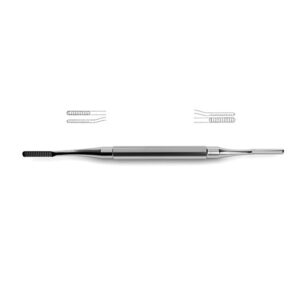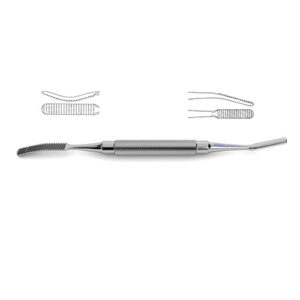| Name | Bone File #12 |
| Lead Time | 0-3 days |
| Specialty | Neuro, Ortho & Spine-Rasps & Files |
| Material Finish | Stainless Steel |
| Grade | Premium Operating Room |
| Units of Measurement | Each |
| Manufacturer | seemab surgical |
| Sterility | Non-Sterile |
| Usage | Reusable |
Bone File #12
double-ended, plain serrations, 7.0 mm & 5.0 mm wide ends, 7″ (17.5 cm)?Bone File #12 can be used in a variety of surgical interventions in neurosurgery or orthopedic surgery. This instrument is double ended with each end featuring plain serrations. It is ideally suited for use in filing bones such as reducing a sharp or jagged bone edge to prevent damage to surround tissue or delicate neuro-vascular bundles. Additionally each even here is a different width: 7.0 mm and 5.0 mm making it versatile enough to be used in a number of different surgical scenarios and can satisfy any surgeon preference.
SKU:
VI-01-1230
Category: Rasps & Files
Description
Shipping & Delivery
Related products
Miller-Colburn File
double-ended, down-cutting teeth, medium & large ends, octagonal handle, 7-1/4" (18.4 cm)?Miller-Colburn File can be used to soften jagged edges or rough surfaces on bone or other hard surfaces. This file features a slim, octagonal body shaft that doubles as a handle from which two different sizes blade extend on either side. Both ends features down-cutting teeth that allow it to grab hold and uniformly file away at a surface such as the skull or vertebral fragment to protect surrounding tissue from damage in craniotomies or spinal surgeries.
Bone File #92B
single-ended, 2.0 mm wide, file inside, backward cutting, angled w/ serrations, 6" (15.0 cm)?Bone File is a highly versatile instrument that can be used in almost any neurosurgical orthopedic procedures. Ranging from craniotomies to spinal surgery this file can be used to file down any types of bone. This can be useful in smoothing down rough edges to prevent catching or tearing of delicate tissues or vasculature during surgical intervention. This instrument is single-ended with the file inside and is angled with serrations and can be used in backward cutting.
Polokoff Rasp
Polokoff Rasp is a highly versatile instrument that is ideal for use in neurosurgical or orthopedic surgical procedures that require manipulation of bone. This rasp can be used to reshape bone slightly to prevent snagging of delicate tissue layers of vasculature. Additionally it can be used to hollow out bone to aid in insertion of implants. This rasp is double-ended and available in two sizes either 3.0 mm and 4.0 mm ends or two 6.0 mm ends making it suitable for a vast majority of patient cases.
Putti Bone Rasp – Flat Blades
flat blades, double-ended flat blades, 18.0 mm width tapers to 4.0 mm, 1 end curved up, 1 end curved sideways, 10-1/2" (26.5 cm)Putti Bone Rasp is an instrument ideally suited for use in surgeries that require handling and particularly mild reshaping of bone such as in neurosurgical or orthopedic surgeries. . This instrument is double ended and features two flat blades. The unique design of this rasp is in the leap shaped silhouette that tapers from 18.00 mm to 4.0 mm that allows it to be fit into slim and narrow spaces and effectively whittle down bone or hard tissue from any angle.
Bone & Skin Rasp
5-1/8" (13.0 cm)?Bone and Skin Rasp is a unique instrument ideal for use in surgical procedures that require manipulation of bone and other hard tissue surfaces. This rasp features a long, slim handle from which extends a spatula like protrusion that has an alternating pattern of dots on it that makes this surface suited for slight filing. Not as abrasive as a file this rasp can be used for the mild reshaping of bone or more delicate semi-solid tissue layers such as bone to prevent sharp edges from causing damage to other adjacent tissue or vasculature.
Bone File – Single-Ended
single-ended, 2-sided convex & flat blade, 23.0 mm width tapers to 6.0 mm, 11" (28.0 cm)?Bone File is a ideally suited for many different surgical procedures. It is specifically designed to be used to file away at bone fragments that are caused by breaks or cuts or on coarse hard tissues in different parts of the body. They can be especially useful in neurosurgical and orthopedic procedures that can involve maneuvering and exploring around many different bony areas such as the skull, long bones and vertebral column. Additionally this file is single sided with a convex and flat blade and a 23.0 mm width that tapers to 6.0 mm.
Bone File – Double-Ended
double-ended, cross-cut, 7" (18.0 cm)?Bone File is a highly versatile instrument that can be used in a vast array of surgical procedures. This file is double ended and is cross cut. The small paddle style blades allow it to be used near delicate tissue areas as are common in neurosurgical procedures and not cause trauma or injury by puncture wound. Additionally use of this file on jagged bone breaks or cuts or even on rough hard surfaces aids in the protected of neurovascular bundles and other tissue layers that are mobilized during surgery that can easily be torn or injured.
Bone File #45
double-ended, plain serrations, 6.0 mm & 5.0 mm wide ends, 7" (17.5 cm)?Bone File #45 is an instrument crafted for use in neurosurgical orthopedic procedures. It features a hexagonal body that also serves as a grip that makes it easy to handle manually. This file is double ended and features plain serrations as well as two different sized ends: 6.0 mm and 5.0 mm. This instrument can be useful in surgical procedures that require filing or reshaping of bone particularly to prevent damage to surround tissue. Ideally it can be used to protect delicate brain tissue and neurovascular bundles from sharp jagged edges from breaks or from cuts made in surgery.













